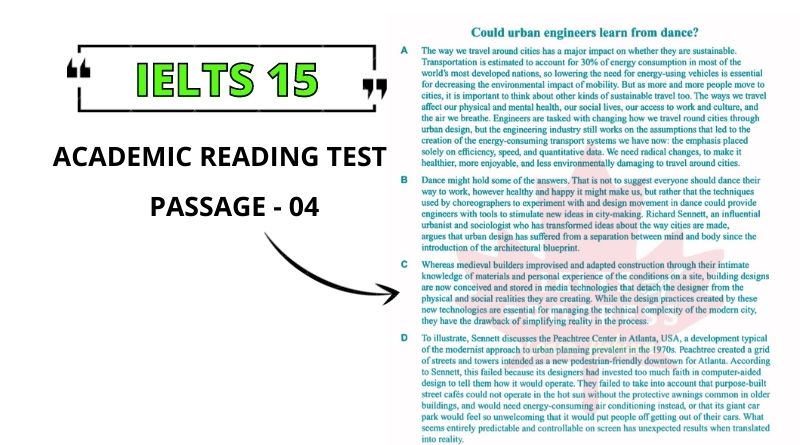IELTS Academic Test – Passage 04: Could urban engineers learn from dance? reading with answers explanation, location and pdf. This reading paragraph has been taken from our huge collection of Academic & General Training (GT) Reading practice test PDF’s.

Could urban engineers learn from the dance?
A
The way we travel around cities has a major impact on whether they are sustainable. Transportation is estimated to account for 30% of energy consumption in most of the world’s most developed nations, so lowering the need for energy-using vehicles is essential for decreasing the environmental impact of mobility. But as more and more people move to cities, it is important to think about other kinds of sustainable travel too. The ways we travel affect our physical and mental health, our social lives, our access to work and culture, and the air we breathe. Engineers are tasked with changing how we travel round cities through urban design, but the engineering industry still works on the assumptions that led to the creation of the energy-consuming transport systems we have now: the emphasis placed solely on efficiency, speed, and quantitative data. We need radical changes, to make it healthier, more enjoyable, and less environmentally damaging to travel around cities.
B
Dance might hold some of the answers. That is not to suggest everyone should dance their way to work, however healthy and happy it might make us, but rather that the techniques used by choreographers to experiment with and design movement in dance could provide engineers with tools to stimulate new ideas in city-making. Richard Sennett, an influential urbanist and sociologist who has transformed ideas about the way cities are made, argues that urban design has suffered from a separation between mind and body since the introduction of the architectural blueprint.
C
Whereas medieval builders improvised and adapted construction through their intimate knowledge of materials and personal experience of the conditions on a site, building designs are now conceived and stored in media technologies that detach the designer from the physical and social realities they are creating. While the design practices created by these new technologies are essential for managing the technical complexity of the modern city, they have the drawback of simplifying reality in the process.
D
To illustrate, Sennett discusses the Peachtree Center in Atlanta, USA, a development typical of the modernist approach to urban planning prevalent in the 1970s. Peachtree created a grid of streets and towers intended as a new pedestrian-friendly downtown for Atlanta. According to Sennett, this failed because its designers had invested too much faith in computer-aided design to tell them how it would operate. They failed to take into account that purpose-built street cafés could not operate in the hot sun without the protective awnings common in older buildings, and would need energy-consuming air conditioning instead, or that its giant car park would feel so unwelcoming that it would put people off getting out of their cars. What seems entirely predictable and controllable on screen has unexpected results when translated into reality.
E
The same is true in transport engineering, which uses models to predict and shape the way people move through the city. Again, these models are necessary, but they are built on specific world views in which certain forms of efficiency and safety are considered and other experience of the city ignored. Designs that seem logical in models appear counter-intuitive in the actual experience of their users. The guard rails that will be familiar to anyone who has attempted to cross a British road, for example, were an engineering solution to pedestrian safety based on models that prioritise the smooth flow of traffic. On wide major roads, they often guide pedestrians to specific crossing points and slow down their progress across the road by using staggered access points divide the crossing into two – one for each carriageway. In doing so they make crossings feel longer, introducing psychological barriers greatly impacting those that are the least mobile, and encouraging others to make dangerous crossings to get around the guard rails. These barriers don’t just make it harder to cross the road: they divide communities and decrease opportunities for healthy transport. As a result, many are now being removed, causing disruption, cost, and waste.
F
If their designers had had the tools to think with their bodies – like dancers – and imagine how these barriers would feel, there might have been a better solution. In order to bring about fundamental changes to the ways we use our cities, engineering will need to develop a richer understanding of why people move in certain ways, and how this movement affects them. Choreography may not seem an obvious choice for tackling this problem. Yet it shares with engineering the aim of designing patterns of movement within limitations of space. It is an art form developed almost entirely by trying out ideas with the body, and gaining instant feedback on how the results feel. Choreographers have deep understanding of the psychological, aesthetic, and physical implications of different ways of moving.
G
Observing the choreographer Wayne McGregor, cognitive scientist David Kirsh described how he ‘thinks with the body’, Kirsh argues that by using the body to simulate outcomes, McGregor is able to imagine solutions that would not be possible using purely abstract thought. This kind of physical knowledge is valued in many areas of expertise, but currently has no place in formal engineering design processes. A suggested method for transport engineers is to improvise design solutions and instant feedback about how they would work from their own experience of them, or model designs at full scale in the way choreographers experiment with groups of dancers. Above all, perhaps, they might learn to design for emotional as well as functional effects.
Questions 1-6
Reading Passage 1 has seven paragraphs, A-G.
Which paragraph contains the following information?
Write the correct letter, A-G, in boxes 1-6 on your answer sheet.
1. reference to an appealing way of using dance that the writer is not proposing
2. an example of a contrast between past and present approaches to building
3. mention of an objective of both dance and engineering
4. reference to an unforeseen problem arising from ignoring the climate
5. why some measures intended to help people are being reversed
6. reference to how transport has an impact on human lives
Questions 7-13
Complete the summary below.
Choose ONE WORD ONLY from the passage for each answer.
Write your answers in boxes 7-13 on your answer sheet.
Guard rails
Guard rails were introduced on British roads to improve the 7…………………… of pedestrians, while ensuring that the movement of 8……………………. is not disrupted. Pedestrians are led to access points, and encouraged to cross one 9…………………….. at a time.
An unintended effect is to create psychological difficulties in crossing the road, particularly for less 10………………….. people. Another result is that some people cross the road in a 11……………………. way. The guard rails separate 12……………………., and make it more difficult to introduce forms of transport that are 13…………………….
________________
ALSO TRY:
1) IELTS 15 READING PASSAGE – DRIVERLESS CARS ↗
2) IELTS 15 READING PASSAGE – WHAT IS EXPLORATION? ↗
1) IELTS 15 READING PASSAGE – NUTMEG: A VALUABLE SPICE ↗
4) IELTS 15 READING PASSAGE – BRING EXTINCT SPECIES BACK TO LIFE ↗
5) IELTS 15 READING PASSAGE – HAVING A LAUGH ↗
________________
Answers with Explanation
Check out Could urban engineers learn from the dance? reading answers below with explanations and locations given in the text.
1. B
2. C
3. F
4. D
5. E
6. A
7. safety
8. traffic
9. carriageway
10. mobile
11. dangerous
12. communities
13. healthy
Have any doubts??? Discuss in the comments ...
If you want the pdf summary of Could urban engineers learn from dance? reading passage and answers, please write your email in the comment section below. We’ll send it across at the speed of light.

ALL THE BEST !